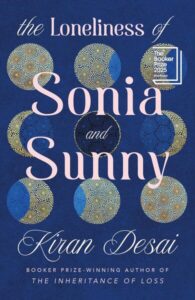It’s been nearly 20 years since Kiran Desai won the Booker Prize with The Inheritance of Loss. Now she finally returns with an epic tale of love, race, migration, art and mysticism which thoroughly deserves its short-listing for this year’s award.
At its heart, the novel is a traditional romance between Sonia, an aspiring novelist, and journalist Sunny, two young Indians given the lucky opportunity, or so their parents assume, to study in America and ultimately achieve the holy grail of a green card. Adrift in New York at the turn of the millennium, they are subjected both to prejudice and predatory relationships. They are also unaware that their respective families are planning an arranged marriage between them. When they finally meet by chance in India, falling in love is easy, until events from the past and their own preoccupations stymie the affair. It takes a trip to Mexico and a showdown between Sunny and Sonia’s former lover, a charismatic and narcissistic artist memorably called Ilan de Toorjen Foss, to get back on track.
Wrapped around the core story is a huge cast of friends and older relatives, both living and dead, as well as the myriad cooks, drivers and maids who look after them. Their stories of love and loss, pre-Partition society and traditional expectations inform and reflect Sonia and Sunny’s experiences. One important theme examined here is the bond between mother and son. Part plot device, part control freak, Babita, Sunny’s widowed mother, is a parent who cares too much. She is also afraid of being left alone, driving Sunny further away. In contrast, Ilan’s mother clearly didn’t care at all, leading to outpourings of tortured bewilderment in his artworks and a penchant for psychological abuse of his younger female partners, including Sonia.
Desai has a broad canvas for social commentary.

By jumping between New York, India, Italy and Mexico, author Desai has a broad canvas for social commentary and an opportunity to compare and contrast the plight of immigrants globally. She cheerfully skewers easy targets such as Babita’s snobbery, Indian corruption and the constant refrain of American tourists that everything in Mexico is “so cheap”. Yet she also exposes more complex problems such as bias in the news narrative, such as when Sunny considers the absurdity of him writing stories about India for the Western press. Desai writes:
There was perhaps a fundamental flaw in a brown person going to the brown world to tell the white world about the brown world, as if he were a white person believing in the centrality of the white world – and because of the central power of Western news outlets, also telling the brown world about itself … The brown world scrambled to gain access to this news (being assured the news was accurate because of Western standards of quality control and fact-checking), and if they knew English they may understand how they were being contained … So a journalist like Sunny … would in the end have no idea who he was, and his readers would have no idea who they were.
While Desai makes it clear that brown people’s labour is keeping rich (mainly white) countries running, she also shows that becoming an immigrant is an act of self-negation. Family, nationality and centuries of artistic tradition must be forsaken to become westernized, as illustrated by Ilan forbidding Sonia to cook curry or write “orientalist nonsense”. (This doesn’t stop him from appropriating her grandfather’s amulet and incorporating it into his art.) Nonetheless, many still aspire to be treated as a non-person in a low-level US job rather than be middle-class in India. It’s a mystery to Babita who considers it strange that “this striving to escape India felt patriotic: If you were a worthy Indian, you became an American.”
Desai moves fluently from comedy to tragedy, satire to suspense, from the poetic to the coarse.
The final gloss on the novel’s many layers is an accent of magical realism. Sonia believes she is being pursued by a ghostly slavering dog, who may be an animus of Ilan (a true monster) or perhaps a manifestation of her self-doubt. Other phantoms and strange dreams flit through the text while recurring motifs of eyes and mirrors lend a sense of the uncanny. Some philosophical musings and thoughts on Western and Eastern art and literature add to the mix.
Ideas are one thing, the way they are presented is another. Here, Desai excels. She moves fluently from comedy to tragedy, satire to suspense, from the poetic to the coarse, always managing to nail the right word or image. Babita, suffering an embarrassing crush on a younger man, feels her heart is “like a dog on a leash, rushing, straining”. Other wonderful soundbites include the pithy “hell hath no fury like a man who is not the center of attention.”
It is conceivable that some may feel the novel too long or that minor characters are given too much bandwidth. Yet this may be deliberate as, like Sonia who fears she will have to write all her stories to find the “center”, Desai realises that essential truths cannot be delivered by a single story and must be intuited from many. She certainly takes her reader on a scenic route to discover that, in the end, love conquers all. But it’s an incredible journey.


You must be logged in to post a comment.